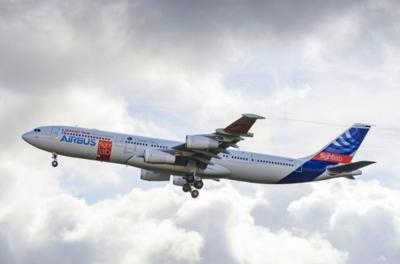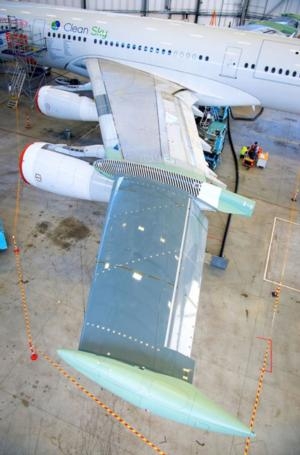First Test Aircraft In The World Combining A Transonic Laminar Wing Profile With A Standard Aircraft Internal Primary Structure
Airbus’ A340 laminar-flow “BLADE” test demonstrator aircraft (A340-300 MSN001) has made its successful maiden flight for the EU-sponsored Clean Sky “Blade” project. The aircraft, dubbed “Flight Lab”, took off from the Tarbes aerodrome in southern France at local time 11:00, and after a series of successful tests it landed at Airbus’ facilities in Toulouse Blagnac. The overall flight time was 3 hours and 38 minutes.

The BLADE project – which stands for “Breakthrough Laminar Aircraft Demonstrator in Europe” – is tasked with assessing the feasibility of introducing the technology for commercial aviation. It aims to improve aviation’s ecological footprint, bringing with it a 50% reduction of wing friction and up to five percent lower CO2 emission. Airbus’ A340 Flight Lab is the first test aircraft in the world to combine a transonic laminar wing profile with a true internal primary structure.
On the outside the aircraft is fitted with two representative transonic laminar outer-wings, while inside the cabin a highly complex specialist flight-test-instrumentation (FTI) station has been installed. The extensive modifications to the A340-300 test-bed aircraft took place during the course of a 16-month working party in Tarbes, with the support of numerous industrial partners across Europe. Today’s first-flight marks the kick-off of the Blade flight-test campaign to explore the wing’s characteristics in flight.
“We began by opening the flight envelope to check that the aircraft was handling correctly,” explains Airbus Flight-Test Engineer, Philippe Seve, who was on board the flight. “We achieved our objective to fly at the design Mach number, at a reasonable altitude and check everything was fine. We also checked that the FTI was working as expected, to identify further fine-tuning for the next flights.”

In the run-up to the start of this flight-testing phase, a small team of 10 specially trained pilots, test engineers and flight test engineers had prepared for this milestone for several months, spending time in a simulator and familiarising themselves with the FTI systems to be installed on the Airbus flight-test aircraft. Moreover, on equipment installation side, a working party of 70 people performed the FTI installation inside the aircraft, while teams from Bremen, Germany and Broughton, UK worked externally on the outer wings, with a team from Stade Germany, installing a pod containing infrared cameras on the fin.
On the wings, there are hundreds of points to measure the waviness of the surface to help Airbus’ engineers ascertain its influence on the laminarity – which is the first time that Airbus has used such a testing method on an aircraft. Other ‘firsts’ are the use of infrared cameras inside the pod to measure wing temperature and the acoustic generator which measures the influence of acoustics on laminarity. In addition, there is also an innovative reflectometry system, which measures overall deformation in real-time during flight.
A key goal of Blade is to be able to measure the tolerances and imperfections which can be present and still sustain laminarity. To this end, Airbus will simulate every type of imperfection in a controlled manner, so that at the end of the campaign the tolerances for building a laminar wing will be fully known. The flight Lab will perform around 150 flight hours in the coming months.
(Images provided with Airbus news release)
 ANN's Daily Aero-Term (04.26.24): DETRESFA (Distress Phrase)
ANN's Daily Aero-Term (04.26.24): DETRESFA (Distress Phrase) ANN's Daily Aero-Linx (04.26.24)
ANN's Daily Aero-Linx (04.26.24) Airborne 04.22.24: Rotor X Worsens, Airport Fees 4 FNB?, USMC Drone Pilot
Airborne 04.22.24: Rotor X Worsens, Airport Fees 4 FNB?, USMC Drone Pilot Airborne 04.24.24: INTEGRAL E, Elixir USA, M700 RVSM
Airborne 04.24.24: INTEGRAL E, Elixir USA, M700 RVSM Airborne-NextGen 04.23.24: UAVOS UVH 170, magni650 Engine, World eVTOL Directory
Airborne-NextGen 04.23.24: UAVOS UVH 170, magni650 Engine, World eVTOL Directory




